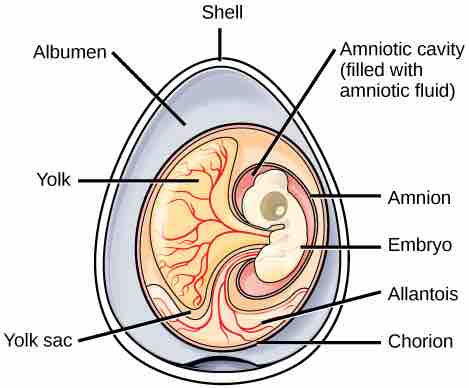Characteristics of Amniotes
The amniotes, reptiles, birds, and mammals, are distinguished from amphibians by their terrestrially-adapted egg, which is protected by amniotic membranes. The evolution of amniotic membranes meant that the embryos of amniotes were now provided with their own aquatic environment, which led to less dependence on water for development, allowing the amniotes to branch out into drier environments. This was a significant development that distinguished them from amphibians, which were restricted to moist environments due their shell-less eggs. Although the shells of various amniotic species vary significantly, they all allow retention of water. The shells of bird eggs are composed of calcium carbonate and are hard, but fragile. The shells of reptile eggs are leathery and require a moist environment. Most mammals do not lay eggs (except for monotremes). Instead, the embryo grows within the mother's body; however, even with this internal gestation, amniotic membranes are still present.
The amniotic egg is the key characteristic of amniotes . In amniotes that lay eggs, the shell of the egg provides protection for the developing embryo while being permeable enough to allow for the exchange of carbon dioxide and oxygen. The albumin, or egg white, provides the embryo with water and protein, whereas the fattier egg yolk is the energy supply for the embryo, as is the case with the eggs of many other animals, such as amphibians. However, the eggs of amniotes contain three additional extra-embryonic membranes: the chorion, amnion, and allantois. Extra-embryonic membranes are those present in amniotic eggs that are not a part of the body of the developing embryo. While the inner amniotic membrane surrounds the embryo itself, the chorion surrounds the embryo and yolk sac. The chorion facilitates exchange of oxygen and carbon dioxide between the embryo and the egg's external environment. The amnion protects the embryo from mechanical shock and supports hydration. The allantois stores nitrogenous wastes produced by the embryo and also facilitates respiration. In mammals, membranes that are homologous to the extra-embryonic membranes in eggs are present in the placenta. Additional derived characteristics of amniotes include waterproof skin, due to the presence of lipids, and costal (rib) ventilation of the lungs.

Amniotic eggs
The key features of an amniotic egg are the chorion, amnion, and allantois.